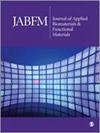Failure Behaviour of Carbon-Epoxy Composite in Crack Arrester and Crack Divider Mode
IF 3.1
4区 医学
Q2 BIOPHYSICS
Journal of Applied Biomaterials & Functional Materials
Pub Date : 2022-03-30
DOI:10.35745/afm2022v02.01.0001
引用次数: 0
Abstract
Failure behaviour of a carbon-epoxy composite is studied both in crack arrester (CA) and crack divider(CD) mode by conducting 3-point bend test of un-notched (UN) and single edge pre-crack notched (N) (notch depth varied from 0.5 to 3.3 mm) specimens at various cross head speeds(CHS) such as 0.2, 50, 100, 200 and 500 mm/min. Influence of notch depth (ND) and CHS on the conditional fracture toughness(CFT) is understood using ANOVA. In both the mode, while the CFT values varies linearly with CHS, its values are observed to be lower at short ND, higher at medium ND and again lower at high ND. In both the modes at high ND (~3.3mm) opening mode/fibre breaking (mode I) failure occurs because of high crack tip stress concentration (as analysed from ANSYS 15.0) which cause fibre failure at the tip and corresponding Mode I fracture toughness was observed to be~20 MPa.m0.5. The composite also shows similar flexural strength both in CA mode (641+48) and in CD mode (634+49 MPa). In CD mode N specimen predominantly fails by mode I. While in CD mode the delamination (mode II) is only observed in UN specimens, in CA mode UN or small N specimen shows mode II failure and medium notched specimen shows mixed mode failure. In CA mode, number of delaminated layer is higher for the specimen tested at high CHS. In CA mode during charpy test (strain rate 103/s), the composite shows numerous delamination and absorbed much higher energy(~40J/cm2) than that in CD (~10J/cm2) mode where mode I failure is predominant. During impact test, lowering of test temperature to -40oC has very little effect on the impact energy since it does not significantly affect the mode of failure.碳-环氧复合材料在阻裂和隔裂模式下的破坏行为
通过在0.2、50、100、200和500 mm/min的十字速度(CHS)下,对未缺口(UN)和单边缘预缺口(N)试件进行三点弯曲试验,研究了碳-环氧复合材料在裂纹止裂(CA)和裂纹分隔(CD)模式下的破坏行为。利用方差分析分析了缺口深度和CHS对条件断裂韧性的影响。在这两种模式下,CFT值随CHS呈线性变化,但在短ND时CFT值较低,在中ND时CFT值较高,在高ND时CFT值又较低。在高ND (~3.3mm)开启模式/纤维断裂(I模式)模式下,由于高裂纹尖端应力集中(由ANSYS 15.0分析)导致尖端纤维破坏,因此在高ND (~3.3mm)模式下,观察到相应的I模式断裂韧性为~20 MPa.m0.5。复合材料在CA模式下(641+48)和CD模式下(634+49 MPa)均表现出相似的抗弯强度。在CD模式下,N试样主要以模式i破坏,而在CD模式下,脱层(模式II)仅在UN试件中观察到,在CA模式下,UN或小N试件表现为模式II破坏,中等缺口试件表现为混合模式破坏。在CA模式下,高CHS时试样的分层层数较高。在charpy试验中(应变速率为103/s),复合材料在CA模式下出现了大量的分层现象,吸收的能量(~40J/cm2)远高于CD模式(~10J/cm2), CD模式以I型破坏为主。在冲击试验中,将试验温度降低至-40℃对冲击能影响很小,对破坏模式影响不大。
本文章由计算机程序翻译,如有差异,请以英文原文为准。
求助全文
约1分钟内获得全文
求助全文
来源期刊

Journal of Applied Biomaterials & Functional Materials
BIOPHYSICS-ENGINEERING, BIOMEDICAL
CiteScore
4.40
自引率
4.00%
发文量
36
审稿时长
>12 weeks
期刊介绍:
The Journal of Applied Biomaterials & Functional Materials (JABFM) is an open access, peer-reviewed, international journal considering the publication of original contributions, reviews and editorials dealing with clinical and laboratory investigations in the fast growing field of biomaterial sciences and functional materials.
The areas covered by the journal will include:
• Biomaterials / Materials for biomedical applications
• Functional materials
• Hybrid and composite materials
• Soft materials
• Hydrogels
• Nanomaterials
• Gene delivery
• Nonodevices
• Metamaterials
• Active coatings
• Surface functionalization
• Tissue engineering
• Cell delivery/cell encapsulation systems
• 3D printing materials
• Material characterization
• Biomechanics
 求助内容:
求助内容: 应助结果提醒方式:
应助结果提醒方式:


